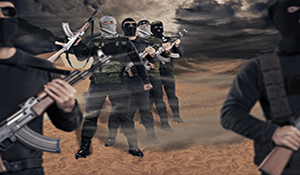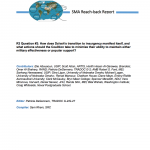Da’esh Transition to Insurgency

Question (R3 #2): How does Da’esh’s transition to insurgency manifest itself, and what actions should the Coalition take to minimize their ability to maintain either military effectiveness or popular support?
Author | Editor: DeGennaro, P. (TRADOC G-2/G-27).
The self-proclaimed Islamic State (IS) or Da’esh, as the group has become known, transition to insurgency is underway. They may not see it like this since Iraq and Syria are struggling with their own sovereignty and trying to restructure governance to support the basic necessities of the populations.
Daniel Serwer of Johns Hopkins University says we can already see this manifesting “in overt terrorist attacks, which are already frequent, as well as more covert intimidation.” IS is conducting suicide, IED and infrastructure attacks daily. The group will continue to be active in organized crime activities – protection rackets, smuggling of oil and antiquities, kidnapping for ransom, and violent intimidation – against any effort to restore law and order. “Daesh will not fold its tent. It may even spawn a new organization to carry on its campaign for the caliphate and seek to embed with other less brutal Salafists,” says Serwer.
In light of the possibility that U.S. backed Iraqi and Peshmerga forces are pushing IS out of its territory in Iraq and beginning to tackle some locations in Syria, Harith Al-Qarawee, professor at Brandeis University, says, “ISIS insurgents who will survive the Mosul battle will return to underground insurgency and seek to secure safe passages between Iraq and Syria.” He and other experts agree that there must be an effective intelligence effort in urban centers to keep abreast of any movements IS may make if another gap in security and governance should open up. Renad Mansour, an expert at Chatham House, reminds us they IS will continue, even underground to “make sure that Iraq’s political elite are unable to come up with a political solution,” so if a political solution is not found, IS will use this as a reason to resurface. The last U.S. Ambassador to Syria, Ambassador Robert Ford, and Elie Abouaoun, at USIP, feel that in order to prevent this from happening, “a genuine and organic national reconciliation effort” must commence by investing in political reconciliation initiatives that combine both top-down and bottom-up approach and include a regional dialogue between Turkey, Iran and Saudi Arabia.
SMEs agree that IS will not disappear. They will most likely go into hiding with sleeper cells in Iraqi and Syrian cities. Many may also remain silent in other Western countries looking for future opportunities to act. Noted anthropologist Scott Atran believes IS “will retreat to its pre-Caliphate tactics, as they did during the Iraqi surge, when they lost 60-80% of their foot soldiers and more than a dozen high-value targets each month for 15 consecutive months, yet still survived with a strong enough organization to seize the initiative in the chaos of the Syrian Civil War and roar back along the old oil-for-smuggling routes that Sunni Arab tribesmen and Saddam loyalists.” Randa Slim of the Middle East Institute states that, “there will be post-ISIS territorial and ideological challenges. On the territorial side of the equation, given the range of actors involved in the Mosul fight, there will be increasing stakes, post-liberation, of competing territorial claims between Baghdad and Erbil but also among different ethnic groups. She continues, “Kirkuk is likely to be a major point of competition in the future and will complicate the relationship between Erbil and Baghdad” and losing territory will undermine ISIS’s caliphate narrative.”
All agree that the Iraqi leadership must find a way to bring the Sunni population into the political decision making by cultivating local leaders who have legitimacy and credibility. Sunni groups, that are particularly fragmented, must contribute to reconstruction of liberated territories and participate in security, police and military, to ensure that their grievances are met. These grievances are rooted in divisions that are embedded by continued attacks on their communities by IS, who are dividing Sunnis as well as Sunnis and Shia populations, and Shia forces perceived to be targeting not only Iraqi Sunnis, but all Sunnis as a proxy for Iran.
Many “IS members are Iraqis,” says Bilal Wahab of the Washington Institute, who were brutally coerced to join IS or had little economic choice, they too should be a focus for immediate reintegration into society to help quell animosities perpetuated in this conflict. Remember, says Altran, “many of the leaders of the Sunni Arab militia in Mosul supported IS at the outset (as “The Revolution” – al Thawra – to win back Iraq from Shia control) and turned against IS when they encourage Sunni to go against Sunni. “Military action and humanitarian assistance are critical, but they are mostly addressing the symptoms, and need to be supplemented by civilian initiatives” says United States Institute of Peace expert Sarhang Hamasaeed. In Diane Maye’s words, “An important element of denying regrowth is to use targeting in conjunction with a broader movement to engage the population against the terrorist network.” In other words, take advantage of an IS retreat by rebuilding and improving the livelihoods of people. That is the main IS deterrent.
Bilal Wahab, Washington Institute, encourages coalition members to take into account several lessons from the past when planning next steps. First, “If grievances continue—mass arrests, kidnappings and economic sidelining, insurgency will remain legitimate in the eyes of the population” and second, “cash speaks louder than ideology, be it foreign funds pouring into Iraq, or Sunni politicians funneling money into violent groups to gain leverage in Baghdad. Finally, “in addition to sectarianism, a chronic malaise of Iraq’s security forces is corruption and has impunity.” This must be addressed immediately. Trust in security forces is the only way populations will support and report ongoing IS activities.
Contributing Authors
Abouaoun, E. (United States Institute of Peace), Atran, S. (ARTIS), Al-Qarawee, H. (Brandeis University), Al-Shahery, O. (Aktis), Ford, R. (Middle East Institute), Hamasaeed, S. (United States Institute for Peace), Ligon, G. (University of Nebraska Omaha), Logan, M. (University of Nebraska Omaha), Mansour, R. (Chatham House); Maye, D. (Embry-Riddle Aeronautical University); McCauley, C. (Bryn Mawr College), Meredith, S. (National Defense University), Mironova, V. (Harvard University), Serwer, D. (Johns Hopkins University), Slim, S. (Middle East Institute), Wahab, B. (Washington Institute for Near East Policy), Whiteside, C. (Naval Postgraduate School)

Comments